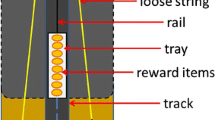Abstract
A short observation of a free ranging Japanese macaque troop at her feeding place provides some evidence about the absence of spontaneous instrumental cooperative behavior in a food getting situation. The experimental situation was designed to test the posibility inMacaca fuscata of collaborative action (removing of heavy baited stones) and sharing of reward. Out of approximately 100 situations only 26 were of social interest. Sixteen in a tolerant fashion and 10 in aggressive one.
Of special interest is that the tolerant cases are almost all the fact of individuals from same affiliative groups and/or from same age’s class (juveniles). Conversely the aggressive cases occur between individuals from different affiliative groups. This is to be related with the social organisation ofMacaca fuscata troop. If the environmental pressure was powerful enough to associate some individuals on the same job this was likely to happen between already acquainted (through grooming for example) individuals.
Similar content being viewed by others
Bibliographie
Azuma, S., 1973. Acquisition and propagation of food habits in a troop of Japanese monkeys. In:Behavioral Regulators of Behavior in Primates,C. R. Carpenter (ed.), Bucknel University Press, pp. 284–292.
Beck, B., 1973, Cooperative tool use by captive Hamadryas baboons.Science, 182: pp. 594–597.
Crawford, M. P., 1937. The cooperative solving of problems by young chimpanzee.Comp. Psychol. Monog., 14(2): pp. 1–88.
Crook, J. H., 1971. Sources of cooperation in animal and man. In:Man and Beast: Comparative Social Behaviour,J. Eisenberg &W. Dillon (eds.), Smithsonian Institution Press, Whashington, pp. 237–260.
Eibl-Eibesfeldt, I., 1970.Ethology: The Biology of Behavior. Holt, Rinehart, & Winston, New York, pp. 175–188.
Fady, J. CL., 1970. Coopération et communication chez les primates.Rev. Comp. Animal., 4(4): 41–49.
————, 1972. Absence de coopération de type instrumental en milieu naturel chezPapio papio.Behaviour, 32: 157–164.
Frisch-Kitahara, J., 1967. Inventive behavior in Japanese monkeys and its implications for our understanding of hominid origins. In:Akten des Anthropologischen Kongresses, Brno, pp. 91–94.
Hall, K. R. L., 1968. Experiment and quantification in the study of baboon behaviour in its natural habitat. In:Primates: Studies in Adaptation and Variability,Ph.C. Jay (ed.), Holt, Rinehart, & Winston, New York, pp. 120–130.
Hinde, R., 1973. On the design of check-sheets.Primates, 14: 393–403.
Kawamura, S., 1959. The process of sub-culture propagation among Japanese macaques.Primates, 2: 43–60.
————, 1961. The societies of vertebrates.Animal Society, I. pp. 17–30.
————, 1961. Some cases of individual difference in the behavior of Japanese macaques.Anim. Sociol., I: pp. 53–74.
Kawai, M., 1965. Newly-acquired precultural behavior of the natural troop of Japanese monkeys in Koshima islet.Primates, 6: 1–30.
Miller, E., 1971. Experimental studies of communication in the monkey. In:Primate Behavior: Developments in Field and Laboratory Research. Vol. 2,A. Rosenblum (ed.). Academic Press, New York, pp. 139–175.
Tsumori, A., 1967. Newly-acquired behavior and social interactions of Japanese monkeys. In:Social Communication among Primates,S. A. Altmann (ed.), University of Chicago Press, Chicago, pp. 207–219.
Yamada, M., 1963. A study of blood-relationship in the natural society of the Japanese macaque.Primates, 4: 43–65.
Author information
Authors and Affiliations
About this article
Cite this article
Burton, J.J. Absence de comportement coopératif spontané dans une troupe deMacaca fuscata en présence de pierres appêtées. Primates 18, 359–366 (1977). https://doi.org/10.1007/BF02383113
Received:
Accepted:
Issue Date:
DOI: https://doi.org/10.1007/BF02383113




